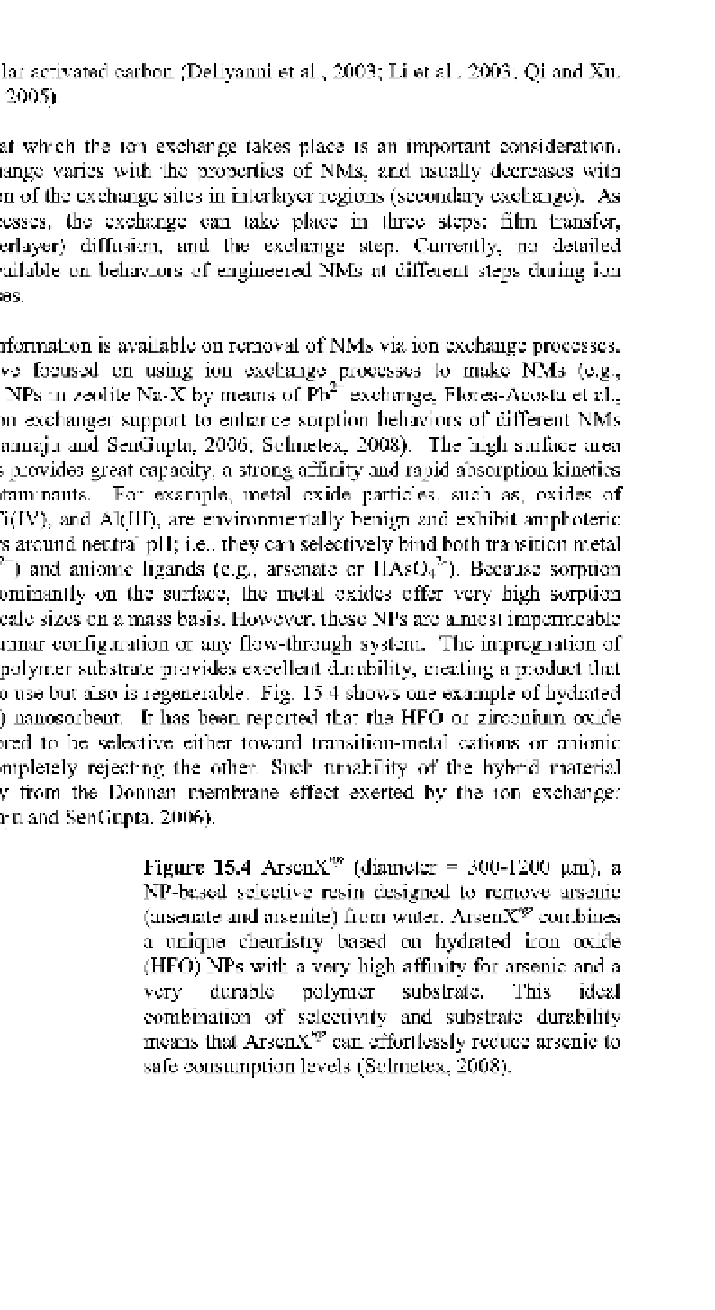Environmental Engineering Reference
In-Depth Information
carbon and granular activated carbon (Deliyanni et al., 2003; Li et al., 2003; Qi and Xu,
2004; Peng et al., 2005).
The rate at which the ion exchange takes place is an important consideration.
The rate of exchange varies with the properties of NMs, and usually decreases with
increasing location of the exchange sites in interlayer regions (secondary exchange). As
in sorption processes, the exchange can take place in three steps: film transfer,
intraparticle (interlayer) diffusion, and the exchange step. Currently, no detailed
information is available on behaviors of engineered NMs at different steps during ion
exchange processes.
Limited information is available on removal of NMs via ion exchange processes.
Most studies have focused on using ion exchange processes to make NMs (e.g.,
synthesizing PbS NPs in zeolite Na-X by means of Pb
+
exchange, Flores-Acosta et al.,
2005) or using ion exchanger support to enhance sorption behaviors of different NMs
(EST, 2006; Puttamraju and SenGupta, 2006; Solmetex, 2008). The high surface area
generated by NPs provides great capacity, a strong affinity and rapid absorption kinetics
for different contaminants. For example, metal oxide particles, such as, oxides of
Fe(III), Zr(IV), Ti(IV), and Al(III), are environmentally benign and exhibit amphoteric
sorption behaviors around neutral pH; i.e., they can selectively bind both transition metal
cations (e.g., Cu
2+
) and anionic ligands (e.g., arsenate or HAsCU
2
"). Because sorption
sites reside predominantly on the surface, the metal oxides offer very high sorption
capacity at nanoscale sizes on a mass basis. However, these NPs are almost impermeable
in fixed-bed columnar configuration or any flow-through system. The impregnation of
these NPs into a polymer substrate provides excellent durability, creating a product that
is not only easy to use but also is regenerable. Fig. 15.4 shows one example of hydrated
iron oxide (HFO) nanosorbent. It has been reported that the HFO or zirconium oxide
NPs can be tailored to be selective either toward transition-metal cations or anionic
ligands while completely rejecting the other. Such tunability of the hybrid material
results essentially from the Donnan membrane effect exerted by the ion exchanger
support (Puttamraju and SenGupta, 2006).
Figure 15.4
ArsenX
B/
)
(diameter = 300-1200 urn), a
NP-based selective resin designed to remove arsenic
(arsenate and arsenite) from water. ArsenX
B/
>
combines
a unique chemistry based on hydrated iron oxide
(HFO) NPs with a very high affinity for arsenic and a
very durable polymer substrate. This ideal
combination of selectivity and substrate durability
means that ArsenX
B/
>
can effortlessly reduce arsenic to
safe consumption levels (Solmetex, 2008).


Search WWH ::

Custom Search